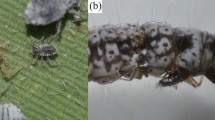Abstract
A complete understanding of the evolution of sociality in aphids requires a detailed knowledge of the patterns of soldier investment in their ecology. The eusocial bamboo aphidPseudoregma bambucicola has a morphologically specialized first-instar soldier caste. The proportion of soldiers was positively correlated with colony size. Within a colony, soldiers were evenly distributed among subcolonies; within each subcolony, however, their distribution was biased toward peripheries which were exposed to many predators. Field experiments introducing natural enemies such asEupeodes confrater (Diptera: Syrphidae) andSynonycha grandis (Coleoptera: Coccinellidae) revealed that the survival rate of these predators was negatively correlated with the density of soldiers, suggesting that soldiers can more or less defend their colonies by killing or removing a range of natural enemies. Observations suggest that large mature colonies attract more predators than newly established small colonies and that, within a colony, the predators attack each subcolony regardless of its position on bamboo shoots. This implies the presence of a positive correlation between colony size and predation risk. Thus, the investment in soldiers seems to reflect the attacking pattern of predators within a colony. These results agree with the defence-optimization hypothesis in soldier investment ofP. bambucicola colonies.
Similar content being viewed by others
References
Akimoto, S. (1996) Ecological factors promoting the evolution of colony defense in aphids: computer simulations.Insectes Sociaux 43: 1–15.
Aoki, S. (1977)Colophina clematis (Homoptera: Pemphigidae), an aphid species with ldsoldiersrd.Kontyû 45: 276–282.
Aoki, S. (1987) Evolution of sterile soldiers in aphids. pp. 53–65.In Y. Itô, J. L. Brown and J. Kikkawa (eds.)Animal societies: theories and facts. Japan Scientific Societies Press, Tokyo.
Aoki, S. and U. Kurosu (1987) Is aphid attack really effective against predators? A case ofCeratovacuna lanigera. pp. 224–232.In J. Holman, J. Pelikan, A. F. G. Dixon and L. Weismann (eds.)Population structure, genetics and taxonomy of aphids and Thysanoptera. SBP Academic Publishers, The Hague.
Foster, W.A. (1990) Experimental evidence for effective and altruistic colony defence against natural predators by soldiers of the gall-forming aphidPemphigus spyrothecae (Hemiptera: Pemphigidae).Behavioral Ecology and Sociobiology 27: 421–430.
Goldberg, D. E. and S. M. Scheiner (1993) ANOVA and ANCOVA: field competition experiments. pp. 69–93.In S. M. Scheiner and J. Gurevitch (eds.)Design and analysis of ecological experiments. Chapman and Hall, New York, London.
Ito, F. and S. Higashi (1990) Tests of four hypotheses on soldier production, by using wild colonies ofPheidole fervida F. Smith (Hymenoptera: Formicidae).Researches on Population Ecology 32: 113–117.
Itô, Y. (1989) The evolutionary biology of sterile soldiers in aphids.Trends in Ecology and Evolution 4: 69–73.
Itô, Y., S. Tanaka, J. Yukawa and K. Tsuji (1995) Factors affecting the proportion of soldiers in eusocial bamboo aphid,Pseudoregma bambucicola, colonies.Ethology Ecology and Evolution 7: 335–345.
Maki, K. and T. Abe (1986) Proportion of soldiers in the colonies of a dry wood termite,Neotermes koshunensis (Kalotermitidae, Isoptera).Physiology and Ecology, Japan 23: 109–117.
Morimoto, M. and H. Shibao (1993) Predators of the bamboo aphidPseudoregma bambucicola (Homoptera: Pemphigidae) in Kagoshima, southern Japan.Applied Entomology and Zoology 28: 246–248.
Ôhara, K. (1985a) Observations on the oviposition behaviour ofMetasyrphus confrater (Diptera: Syrphidae) and the defensive behaviour of soldiers ofPseudoregma bambucicola (Homoptera: Pemphigidae).Esakia 23: 99–105.
Ôhara, K. (1985b) Observations on the prey-predator relationship betweenPseudoregma bambucicola (Homoptera: Pemphigidae) andMetasyrphus confrater (Diptera: Syrphidae), with special reference to the behaviour of the aphid soldiers.Esakia 23: 107–110.
Oster, G. F. and E. O. Wilson (1978)Caste and ecology in the social insects. Princeton University Press, Princeton.
Sakata, K. and Y. Itô (1991) Life history characteristics and behaviour of the bamboo aphid,Pseudoregma bambucicola (Homoptera: Pemphigidae), having sterile soldiers.Insectes Sociaux 38: 317–326.
Sakata, K., Y. Itô, J. Yukawa and Sk. Yamane (1991) Ratio of sterile soldiers in the bamboo aphid,Pseudoregma bambucicola (Homoptera: Pemphigidae), colonies in relation to social and habitat conditions.Applied Entomology and Zoology 26:463–468.
Schütze, M. and U. Maschwitz (1991) Enemy recognition and defence within trophobiotic associations with ants by the soldier caste ofPseudoregma sundanica (Homoptera: Pemphigidae).Entomologia generalis 16: 1–12.
Shibao, H. (1997) Some wing-padded larvae ofPseudoregma bambucicola (Homoptera: Aphididae: Hormaphidinae) overwinter and develop into virginoparae.Applied Entomology and Zoology 32: 459–464.
Sokal, R. R. and F. J. Rohlf (1995)Biometry, 3rd edn. Freeman and Campany, New York.
Stern, D. L., S. Aoki and U. Kurosu (1994) A test of geometric hypotheses for soldier investment patterns in the gall producing tropical aphidCerataphis fransseni (Homoptera: Hormaphididae).Insectes Sociaux 41: 457–460.
Stern, D. L. and W. A. Foster (1996) The evolution of soldiers in aphids.Biological Reviews of Cambridge Philosophical Society 71: 27–79.
Stern, D. L. and W. A. Foster (1997) The evolution of sociality in aphids: a clone’s-eye view. pp. 150–165.In J. Choe and B. Crespi (eds.)The evolution of social behavior in insects and arachnids. Cambridge University Press, Cambridge.
Stern, D. L., J. A. Whitfield and W. A. Foster (1997) Behavior and morphology of monomorphic soldiers from the aphid genusPseudoregma (Cerataphidini, Hormaphididae): implications for the evolution of morphological castes in social aphids.Insectes Sociaux 44: 379–392.
Sunose, T., Sk. Yamane, K. Tsuda and K. Takasu (1991) What do the soldiers ofPseudoregma bambucicola defend?Japanese Journal of Entomology 59: 141–148.
Tanaka, S. and Y. Itô (1994) Reversal of caste production schedule in a eusocial aphid,Pseudoregma koshunensis.Naturwissenschaften 81:411–413.
Tanaka, S. and Y. Itô (1995) Interrelationships between the eusocial aphid,Pseudoregma bambucicola, and its syrphid predator,Eupeodes confrater.Japanese Journal of Entomology 63: 221–228.
Trivers, R. L. and H. Hare (1976) Haplodiploidy and evolution of social insects.Science 191: 249–263.
Wilkinson, L. (1992)SYSTAT: The system for statistics. SYSTAT Inc., Evanston, Illinois.
Author information
Authors and Affiliations
Rights and permissions
About this article
Cite this article
Shibao, H. Social structure and the defensive role of soldiers in a eusocial bamboo aphid,Pseudoregma bambucicola (Homoptera: Aphididae): A test of the defence-optimization hypothesis. Res Popul Ecol 40, 325–333 (1998). https://doi.org/10.1007/BF02763464
Received:
Accepted:
Issue Date:
DOI: https://doi.org/10.1007/BF02763464




